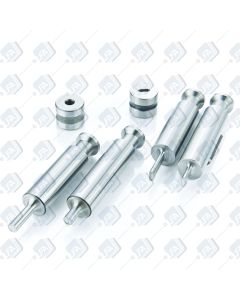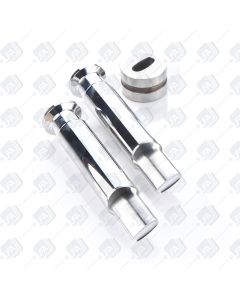Custom Tooling Form
Custom Tooling Form: www.lfamachines.com/custom-punch-dies-tooling
Different Types of Tooling: https://youtu.be/W1jNGuq7bCA
Tooling Terminology: https://youtu.be/UOfBT-dTig8
Custom Tooling Form
Welcome to LFA’s video on filling in our custom tooling form.
This video will show you how to fill out our custom tooling form and allow us to be able to provide you a custom tablet design.
The web address for our custom tooling form is: www.lfamachines.com/custom-punch-dies-tooling
First start out with your full name, company and email address. Your email address is really important as it allows us to contact you and provide you with your custom tooling reference number.
Selecting your country is also important. This will allow us to send your order to the relevant sales team. It also allows us to check any local restrictions that may be in place in your country.
If you have had this same design from us before, select "Yes", and then complete your request number, which can be found on the bottom right of your previous tooling design sheet.
Tell us how many sets you need, remembering one set consists of an upper punch, a lower punch and a die.
Then fill out any extra notes you’d like the team to know, and then click the "captcha" followed by "submit".
However, if you’ve not had this tooling made by us before, select “No” under “Have you had this design made by us before?”
This will then reveal additional information that is required.
We’ll now go through this, section by section.
Tooling Requirements
If you need additional information, we have a video covering different types of tooling, starting with the tooling type.
EU is the ISO18084 specification.
TSM is the tooling manual specification by the American Pharmaceutical society.
However, we are in the process of transitioning to EU specification tooling.
TDP tooling is the tooling made specifically for our Desktop tablet presses.
If your tablet press uses a specification of tooling that is not in the list, then please select “Other”. You can then write the specification you are using. If you have a link to that particular specification, please provide it in this box.
For the purposes of this example in the video, we have selected EU specification tooling.
Under "tooling size", we have four sub-categories, which are the same for both the EU and TSM styles of tooling, and which we can provide in D, B, BB, DB or "other" formats. If you require "other", there is a box in which you can provide additional information.
For the purposes of this video, we have selected "D".
On the LFA website, you can find a Tablet Press Tooling Specification Guide, which is linked in the description below. This shows the tooling sizes and variations, as well as a video which will take you through each size.
Please then select your unit of measurement, either metric (millimetres) or imperial (inches).
Punch Material
This is the current selection of materials we can supply our tooling in. Each has different properties which give them different capabilities. Although S7 is pretty much the standard choice, others may be everso slightly softer, which allows the tools to press at a higher pressure; others are more rust resistant etc. It is important, therefore, to research the steel that maybe best for your tooling.
If you are having issues with sticking or picking, or you need your tooling to be more rust resistant, you can choose to coat your tooling with one of the following:
- Chrome Plating - is used for wear and corrosion.
- PVD Titanium Nitride - Anti corrosive and improves hardness.
- PVD Chromium Nitride - Anti corrosive and wear resistant but also has low coefficient of friction.
Chrome Plating - is used for wear and corrosion.
PVD Titanium Nitride - Anti corrosive and improves hardness.
PVD Chromium Nitride - Anti corrosive and wear resistant but also has low coefficient of friction.
However, as standard, we do not recommend a coating unless you are having issues with pressing your formulation, and you have exhausted all other options.
Bellows and oil cups
Bellows
Bellows are used on upper punches that have a bellow groove to prevent dust from getting up between the punch guide hole and upper punch barrel. If you are using a formulation with excessive fines, powder can make its way onto the upper punch barrel and stick to the punch lubrication. This will eventually make your tooling sluggish, wear out your turret, and may create scorched formulation that would fall onto the die table and back into your formulation, causing black spots within your tablets.
Oil Cups
Oil cups are installed on the stem of your upper punch to catch excess oil that may potentially drip down from your punch barrel, and prevent it from getting into your die table.
Tablet Design
Now is the time to choose the shape of your tablet. Under "tablet shape" you will find a list of standard tablet shapes.
Click on your desired shape, and you will then be asked for the dimensions of the shape. In this example, we'll select a Hexagon.
Here it’s requesting two dimensions. If you have two vertical lines like this, it’s requesting the dimensions between those two points. Let’s say we want our tablet width to be 8 mm, and then when you see an arrow pointing at a curve, it’s asking for the radius of that curve.
As another example, let's look at a bullet shape. Three measurements are required: the distance between the two points on dimension 1, and the same again for dimension 2, and then the radius of the curved corner on dimension 3.
Thus, if there are two lines depicted, you need to give the measurement between those two points; and where there is an arrow, you need to give the radius of that curve.
If you are unsure of the radius of the curve, you may leave this blank, and we’ll take an educated guess on the radius.
Multi Tip Tooling
Multi tip tooling presses multiple tablets on every punch, and can be used to increase your production capacity. However, it is not suitable for every design of punch and can be quite expensive. If you are considering multi tip tooling, we strongly suggest talking to a member of the LFA team before proceeding.
Tablet Coating
If your tooling includes lettering or logos, and you are considering coating your tablets after production, then we would need to make the letting or logos a bit deeper to avoid the coating solution from filling in the imprints.
Face profile
Under "face profiles", you will find a full range of face profiles from "flat face with bevel" to a "lozenge". The most common choice is a "flat face with bevel". It is important to research face profiles before making your decision, as some tablet shapes and face profiles require extra tooling and cause wear to the tablet press, which can be costly.
Upper Punch Design
You now need to choose what design you would like on your upper punch. For example, if you want lettering, select "text", and type the text you require into the text box.
For the purposes of this example we’ll type "LFA".
Then under "font", choose either "standard" or "bold". The fonts used are two standard fonts from the TSM manual.
If you require a different font or a logo, then at the top by "Image logo/text" select "Image". When uploading your image, we strongly suggest you upload it in a vector file or pdf format.
Under "image position" for both text and image, if you choose "upper centralised" then the image gets curved around the upper part of the tablet, and the same with "lower centralised".
If you want both text and a logo to be on one tablet, again select "image" and upload it directly. Then at the bottom of the form below "Lower punch design". there’s a note section where extra information can be given.
Land Size (mm)
The "land" is on the very edge of the tooling cup. LFA recommends this to be 0.05 mm as standard. If it is any larger, it would be visible on the tablet and create a flat edge. It may also cause issues with ejection. For these reasons, 0.05 mm is the ideal size.
Margin (mm)
This is the distance from the edge of the tablet to where the logo starts. If you opt for your logo to be "centralised", then the margin becomes less important. However, if you select the position of the logo to be "upper centralised" then the text would start, in this example, 1 mm from the edge.
Next you select if you need any breaker lines. We have a selection of these to choose from, the most common of which are the quadrisect and the standard breaker line. It is possible to have both a breaker and a logo on a tablet face. However, the position of the logo needs to be taken into consideration. For example, if a standard breaker line is being used, it would not be possible to centralise the logo; instead, it would need to be placed in the upper or lower centralised position.
Lower Punch Design
For the lower punch design, you need to follow exactly the same steps as before. This is to give you the option of selecting a different design for the top and bottom of your tablets, for example a logo on top and a milligram dosage on the reverse, or perhaps a logo on one side and a breaker line on the other.
We strongly suggest you keep the land size the same as the upper punch.
Other Information
Do you require the dies to be carbide lined? Most of the time the answer to this would be "no". The reason for using carbide lined dies would be if you’re forming abrasive or corrosive materials. It should be mentioned that these can be extremely expensive, so it is best to explore all options.
Under "Die taper", you can select if you want your die to be tapered. Adding a taper helps air to escape the die bore faster. Adding a double taper would allow you to flip the die during its working life, prolonging the life of the die.
It is not possible to have a double taper on a tablet that is being produced more than 50% down in the die, as the die taper would then be working against you to eject the tablet.
A single taper is a great help for products where you need to assist the ejection of the tablet, for example if you have a sticky product, problems with capping etc.
However, if you are pressing a simple product such as caffeine tablets, or your product isn’t sticky, then having no taper should be fine.
Then fill out how many sets you require, remembering a set consists of an upper punch, a lower punch and a die. There is a minimum order quantity of 5 sets and we always suggest ordering one extra set.
Extra information that is really helpful to our team includes:
- The make and model of your machine
- Whether you want the upper and lower punches to be keyed - and if so, what key configuration you would like
Once this is complete, click on the captcha and submit the form.
The next page will provide your custom tooling number which you can use in future communications with LFA.


